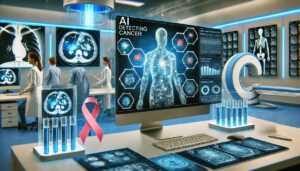Pathology, the backbone of medical diagnostics, has witnessed a wave of transformative innovations in recent years. As technology advances, diagnostic testing has become more precise, accessible, and efficient. These innovations are reshaping the landscape of healthcare and enabling early disease detection, personalized medicine, and improved patient outcomes. In this blog post, we explore the latest innovations in pathology, focusing on their implications for modern healthcare.
The Role of Technology in Advancing Pathology
The integration of advanced technologies into pathology has revolutionized diagnostic processes. From artificial intelligence to molecular diagnostics, these breakthroughs offer clinicians powerful tools to understand complex diseases better.
Artificial Intelligence (AI) in Pathology
Artificial intelligence has emerged as a game-changer in pathology. AI-powered algorithms assist pathologists in analyzing complex data, identifying patterns, and diagnosing diseases with remarkable accuracy. Key advancements include:
- Digital Pathology: AI enables the digitization of pathology slides, allowing remote consultations and second opinions. This innovation supports telemedicine by bridging the gap between patients in remote areas and specialized healthcare providers.
- Predictive Analytics: Machine learning models predict disease progression and response to treatments, enabling personalized care.
- Automated Workflow: AI streamlines lab workflows by automating routine tasks such as sample sorting and preliminary analysis, reducing turnaround times.
Molecular Diagnostics: Precision at the Genetic Level
Molecular diagnostics represents a paradigm shift in pathology, focusing on genetic and molecular markers for precise diagnoses. Advances in this field include:
- Next-Generation Sequencing (NGS): NGS allows comprehensive genetic analysis to identify mutations associated with diseases like cancer and genetic disorders.
- Liquid Biopsies: These non-invasive tests detect cancer biomarkers in blood samples, offering an alternative to traditional biopsies.
- Companion Diagnostics: These tests guide therapeutic decisions by identifying biomarkers that predict response to specific treatments.
Telemedicine: A New Era in Pathology Services
Telemedicine has gained momentum in recent years, and its integration into pathology is transformative. The ability to consult with specialists remotely has made pathology services more accessible and efficient.
Enhancing Accessibility
Telemedicine enables patients in underserved areas to access expert opinions without the need for travel. For example, digital pathology slides can be shared with specialists worldwide, ensuring timely and accurate diagnoses.
Streamlining Workflow
Pathologists can collaborate in real time through telemedicine platforms, leading to faster decision-making and improved patient care. This innovation is particularly beneficial during emergencies where rapid diagnoses are critical.
Supporting Remote Learning
Telemedicine also supports education and training for pathology professionals by facilitating virtual slide reviews and interactive discussions.
Innovations in Imaging Technologies
Advancements in imaging technologies have significantly impacted pathology, offering detailed insights into cellular structures and disease mechanisms.
Digital Microscopy
Digital microscopy converts traditional glass slides into high-resolution digital images, enabling pathologists to analyze samples on digital platforms. This innovation enhances collaboration and enables AI integration for image analysis.
3D Imaging
3D imaging provides a comprehensive view of tissues, helping pathologists understand complex disease processes better. This technology is especially valuable in cancer research and organ-specific diagnostics.
Automation in Pathology Laboratories
Automation has streamlined laboratory operations, improving efficiency and accuracy. Key developments include:
- Automated Staining and Processing: Machines now handle staining, tissue embedding, and sectioning, reducing human error and ensuring consistency.
- Robotics: Robots assist in sample handling, speeding up processes and minimizing contamination risks.
- High-Throughput Testing: Automated systems can process large volumes of tests simultaneously, addressing the growing demand for diagnostics.
Advancements in Point-of-Care Testing (POCT)
Point-of-care testing has made diagnostics more accessible by enabling tests at or near the patient’s location. Innovations in POCT include:
- Portable Devices: Handheld devices for blood glucose, cholesterol, and infectious disease testing offer quick results.
- Wearable Sensors: Wearable devices monitor health parameters in real time, supporting chronic disease management.
- Smartphone Integration: Mobile apps and devices connected to smartphones facilitate easy data tracking and sharing with healthcare providers.
Impact of Innovations on Healthcare Delivery
The adoption of these innovations in pathology has far-reaching implications for healthcare delivery:
- Early Disease Detection: Advanced diagnostic tools identify diseases at earlier stages, improving treatment outcomes.
- Personalized Medicine: Genetic and molecular insights enable tailored therapies that maximize efficacy and minimize side effects.
- Cost Reduction: Automation and POCT reduce diagnostic costs, making healthcare more affordable.
- Improved Patient Experience: Faster and less invasive tests enhance patient comfort and satisfaction.
Challenges and Future Directions
While innovations in pathology offer tremendous benefits, they also present challenges:
- Cost of Implementation: High costs of advanced technologies may limit their adoption in resource-constrained settings.
- Data Security: Digital pathology and telemedicine raise concerns about patient data privacy and cybersecurity.
- Training and Adaptation: Pathologists and lab technicians need training to adapt to new technologies effectively.
Looking ahead, the focus will be on overcoming these challenges and expanding the reach of innovative diagnostic tools. Research and development efforts are expected to yield even more advanced solutions, paving the way for a brighter future in healthcare.
Conclusion
The landscape of pathology is evolving rapidly, driven by groundbreaking innovations that are transforming diagnostic testing. From AI and molecular diagnostics to telemedicine and automation, these advancements are revolutionizing healthcare by enhancing accuracy, accessibility, and efficiency. As these technologies continue to develop, they hold the promise of improving patient outcomes and shaping the future of medicine.
By embracing these innovations in pathology, the medical community can address emerging healthcare challenges and provide better care for all.
- Inbound Link: Explore more about digital pathology and its impact on healthcare.
- Outbound Link: Read the latest research on advancements in pathology.




